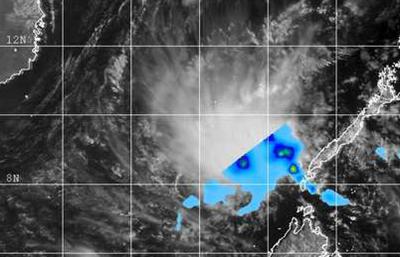NASA sees remnants of TD04W dissipating in South China Sea

This composite image from NASA's TRMM satellite and the MTSAT-2 shows the position of Tropical Depression 04W's remnants in the South China Sea, northwest of Palawan. Credit: NRL/NASA
NASA's Tropical Rainfall Measuring Mission or TRMM satellite passed over the South China Sea on March 25 at 02:56 UTC/March 25 at 10:56 p.m. EDT and gathered data on rainfall rates occurring in the remnants of TD04W.
The image showed that the rainfall associated with the storm had moved away from Palawan and were only falling over the South China Sea.
TRMM's Precipitation Radar instrument showed isolated areas where rain was falling at a rate of 1 inch/25.4 mm per hour.
Over the next several hours, rainfall rates waned as strong easterly wind shear continued to weaken the storm.
By 14:30 UTC/10:30 a.m. EDT on March 25, the Joint Typhoon Warning Center noted that the TD04W's remnants dissipated near 8.8 north and 115.6 east, that's about 540 nautical miles/621.4 miles/1,000 km east of Ho Chi Minh, Vietnam. TD04W is no longer suspect for regeneration.
Media Contact
More Information:
http://www.nasa.govAll latest news from the category: Earth Sciences
Earth Sciences (also referred to as Geosciences), which deals with basic issues surrounding our planet, plays a vital role in the area of energy and raw materials supply.
Earth Sciences comprises subjects such as geology, geography, geological informatics, paleontology, mineralogy, petrography, crystallography, geophysics, geodesy, glaciology, cartography, photogrammetry, meteorology and seismology, early-warning systems, earthquake research and polar research.
Newest articles

Sea slugs inspire highly stretchable biomedical sensor
USC Viterbi School of Engineering researcher Hangbo Zhao presents findings on highly stretchable and customizable microneedles for application in fields including neuroscience, tissue engineering, and wearable bioelectronics. The revolution in…

Twisting and binding matter waves with photons in a cavity
Precisely measuring the energy states of individual atoms has been a historical challenge for physicists due to atomic recoil. When an atom interacts with a photon, the atom “recoils” in…

Nanotubes, nanoparticles, and antibodies detect tiny amounts of fentanyl
New sensor is six orders of magnitude more sensitive than the next best thing. A research team at Pitt led by Alexander Star, a chemistry professor in the Kenneth P. Dietrich…





















